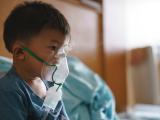Sep 9, 2009 (CIDRAP News) In a follow-up to new influenza guidelines for child care settings, federal experts were on hand today during a Web telecast to answer questions from parents, focusing on child care and concerns about youngsters who have chronic health conditions such as asthma and diabetes.
On Sep 4, the US Centers for Disease Control and Prevention (CDC) issued new guidance to help child care settings respond to pandemic and seasonal influenza outbreaks. The guidance includes measures such as performing daily health checks on kids and staff and urging parents to have their children receive seasonal and pandemic H1N1 flu immunizations.
A day earlier a CDC report on pediatric deaths from novel H1N1 infections in children revealed that those who have neurodevelopmental and other chronic conditions seem to be bearing the heaviest fatality burden. The United States and other countries have also reported the highest novel flu illness rates in younger people, especially children.
Dr Roberta Lavin, director of the office of human service emergency preparedness in the Department of Health and Human Services' Administration for Children and Families, told viewers that about 10 million of the nation's children are in child care settings. She said the daily health checks can be used as an educational ritual for young children and that teaching good hand washing technique, as well as proper cough and sneeze procedures, can yield long-lasting benefits.
"This is a teaching opportunity for the kids. It will serve them well the rest of their lives," she said.
Two CDC expertsone on childhood diabetes and the other on asthmaadvised parents of children with those and other conditions to see their physicians at the start of flu season to make sure the conditions are well controlled.
Dr Ann Albright, director of the CDC's diabetes translation division, said children are at higher risk of infection if their chronic conditions aren't closely managed. She said infections such as influenza can make it difficult to control blood sugar and that people with diabetes typically have "sick day rules" for adjusting their intake of calorie-free fluids, carbohydrates, and medication.
Diabetic patients with influenza symptoms should start paying attention to their ketone levels when glucose levels rise, not just when they have a fever, Albright said. Emergency preparations for diabetic patients should include keeping an adequate supply of medication, test strips, food, and water.
Dr David Callahan, a medical officer for the CDC's asthma team, said parents of children with asthma should check in with their doctor to make sure the "asthma action plan" is up to date and to make sure that the child has an adequate supply of routine and rescue medications.
Both Albright and Callahan recommended that children with chronic conditions should see a physician at the first sign of flu so they can receive early antiviral treatment. They also reminded parents that children with asthma and diabetes should not receive the live attenuated influenza vaccine (FluMist).
Several viewers who e-mailed questions to the experts during the live Webcast had concerns about specific child care issues.
For example, viewers asked if any special procedures are needed to disinfect toys and other shared items. Officials said the guidance recommends following routine cleaning procedures with normal washing solutions. They urged child care operators to set aside an area with separate toys for sick children to play and be supervised until their parents arrive to take them home.
Other viewers had questions about how to identify influenza in children and distinguish it from other respiratory illnesses. Dr Georgina Peacock, developmental pediatrician at the CDC, urged providers to consult healthcare experts in their area for tips about what illnesses are circulating in the area as a way to get more details on symptoms to watch for.
Callahan said it can be difficult to tell the difference between flu, colds, and allergies, but he said influenza is something that many children haven't experienced before, and they often feel significantly sicker than with other common respiratory illnesses.
A viewer asked what child care centers should do if a pandemic H1N1 infection is confirmed in one of the children. Peacock advised that centers notify parents with the same system they use for other infections.
Robin Stephenson, acting president of the National Association of Child Care Professionals, told CIDRAP News in an e-mail that the CDC guidance for child care settings offers a comprehensive look at what centers may face during the upcoming flu season. "While being hypervigilant on following the good rules of hygiene, centers should take seriously the recommendations for updating crisis plans and procedures," he wrote.
However, he raised concerns about the ability of the centers to operate if staff is out sick or caring for ill family members. "State regulatory agencies will need to institute a bit of leniency in the regulations covering substitute qualifications and ratios, as centers may find it extremely difficult to find the coverage needed," he added.
He also urged employers to show stronger support for working parents. Not allowing parents to stay home with sick children might push them to bring sick children to child care centers. "Providing work-at-home options where possible will vastly reduce the stress and temptation to take a sick child to the child care center," he wrote.
Today's Web telecast will be archived soon on the federal flu.gov Web site.
See also:
Sep 4 CIDRAP News story "CDC issues advice for battling flu in child care settings"
Sep 3 CIDRAP News story "CDC report sheds light on pandemic H1N1 deaths in children"
Federal influenza Web site



















